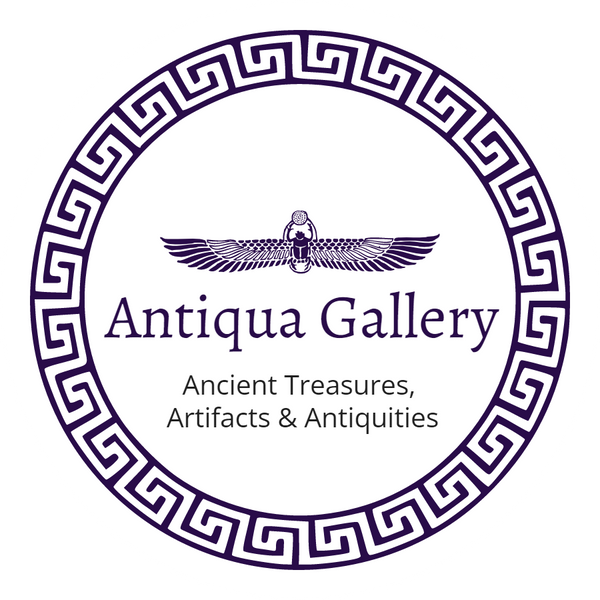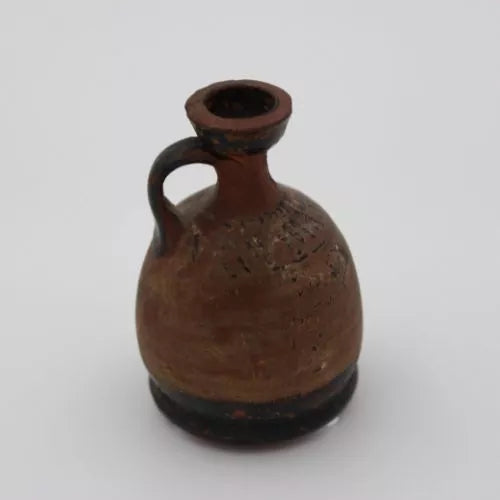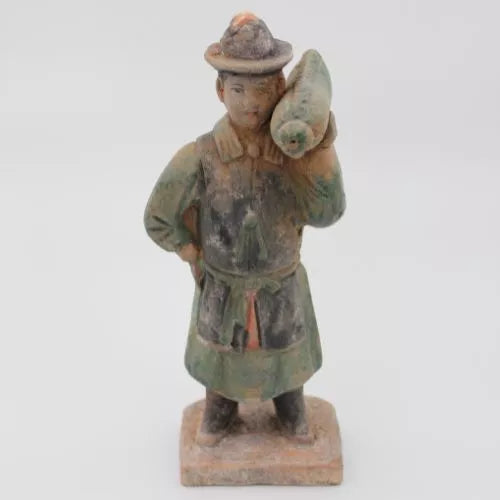The Origins
The very first oil lamps were very simple in their design, and were not much more than an
open saucer (The first ones didn't have wickrests, they were basically just dishes with burn marks - simpler than the one in the link). However, through persistent development of the lamp over a couple of thousand years, it became a very sophisticated vessel, both economically and artistically.
In the Bronze age in the near east, around 3000 BC, there are signs that open saucers as oil lamps started to become popular - high dishes with burn marks. From the end of the early bronze age and onwards till the middle bronze age, the standard oil lamp became
the one with 4 nozzles - the reason for this is that it's assumed to be able to provide more light. It was in the late bronze age period that pottery makers started to create the saucers with a single wick rest instead of the ones with four, a fine example is found
here. This proved to be a great success and the lamps remained quite simple for the next 1.000 years. In general the wick rest/nozzle has a tendency to become more and more pronounced throughout time. Besides this the oil lamps wick rest would be turned more and more inwards, almost ‘closing’ the wick rest - see
this example.
But it was only around 800 BC, that lamps started to become progressively more intricate, efficient and beautiful.
During the 1st millennium BC it became in general smaller - however with the same shape and design. Around the 7th century BC, the oil lamp with a bridged nozzle started to appear (
Howland Type 9). This was an important invention as it held the wick in place much more securely. The lamp was made in two separate sections, which were afterwards fixed together. One for the body, and one for the nozzle. This form of lamp was first produced in Asia Minor and then introduced to the Greek regions.
Greek Oil Lamps
In the 7th century BC the greek had begun to refine the near eastern oil lamp, which had also been used by the mycenaean and minoan people throughout the 2nd millenium BC. The Howland Type 1 and Howland Type 2B are great examples of the early Greek oil lamps. However they quickly developed a lamp with a more noticeable nozzle and circular body, the circular body was a result of fashioning the body and nozzle separately - therefore the shape of the body was simply made circular when spinning the clay on the potter’s wheel. The nozzle and body was flat and level, and it remained like this into the 4th century BC. Throughout the early period of greek oil lamps a huge development happened rather rapidly. The rims became more and more closed, and it began to look like the oil lamps we know from the roman period.
Another development in the late 6th century BC was the standardisation of a
flat rim. This also created the possibility of applying a slip and making some of the first artistic designs. Shortly thereafter rounded rims became popular. The
Howland Type 22B with a central tube represents the typical oil lamp around the 6th and 5th century BC.
Throughout the 4th and 3rd century BC, the oil lamp industry was characterised by producing more chubby lamps - for example
this attic type or
this. The greek had in general a very functional and practical view of the oil lamp. It was quite far from the Roman imperial lamps. The Greek lamps were mostly somewhat open (because they were wheel-made, and not mould-made) - it was first around the fourth century BC that they started to be really closed. And artistically they were very simple - the Greeks painted the lamps with a black paint, and sometimes leaving areas around the round or globular lamp without paint - just like the Howland Type 22B lamp in the next paragraph.
A feature that was more unique for the greek lamp was a cone within the lamp, the function of this cone is not 100% sure - it might have been for handling the lamp -
this article comes with a great idea and quite likely theory of its use. These cones appeared from the seventh to second century BC - however mostly in the beginnings of the greek oil lamp, the
Howland Type 22B is a great example of this cone. A stylistic tendency of the greek oil lamps was for them to have a very circular and round body.
And around the 4th century BC they started to gain height and become much more robust. They became a bit more chubby -
Howland Type 25 A Prime,
Attic Type or
Howland Type 33A.
Between the 6th and 4th centuries BC quite a lot of oil lamps had a horizontal round handle. However these handles frequently broke due to being fragile. Besides, these handles weren't really necessary due to the fact that one could hold the lamp in the palm of a hand.
Around the 3rd century BC handles were almost non-existent.
Around the 4th century BC a lug started to appear. A lug that would increase the ergonomical properties of the greek lamp.
Unfortunately, I haven't found an example of this on the internet I can refer to - however I will update this article when I do.
Hellenistic Oil Lamps
Now to the hellenistic oil lamps... Almost all oil lamps from the hellenistic were
mould-made and not wheel-made. The plaster or clay moulds are thought to have originated from Egypt, around the 3rd century BC. This gave way to true mass production. This is also the reason why many hellenistic oil lamps have
several nozzles. The lamps also became artistically speaking a lot more interesting, and more detailed. And definitely a lot less round and globular, compared to the Greek lamps. This is due to the fact that the artisant wouldn't have to apply the details every time, and didn't have to shape the inside of the oil lamp while the clay was on the wheel. They could mould 2 pieces and make a lamp that was almost completely closed.The mould technique paved the way for the roman imperial oil lamps which are next in line. However first a bit more about the hellenistic lamps, their tendencies and characteristics.
The Ephesus Lamps (Howland Type 49A, 52F and 55B) are perfect examples of how big a change that happened. As you can see the body is a lot less globular, the rim is even more closed, and the nozzle is a lot longer. The lamp is generally speaking a more elegant and artistically complex piece. The rim is highly decorated, with motifs such as vases, masks and palms at the nozzle. In the hellenistic period the oil lamps also started to have small lugs in the side of the lamp, see example
here - due to the mould they had more of an ability to play with the shapes, and ergonomic designs of the lamps. A tendency throughout the hellenistic period is the play with the design of the lamp, always trying to make it more economic and overall better and more beautiful.
By the 2nd century BC a sunken top had become a standard, this helped catching the oil when filling it. As you can see there were a lot of innovations in the Hellenistic period. Another one was the development of a channel connecting the sunken top to the hole for the wick. However this channel didn’t truly gain popularity till the Roman Imperial period.
Because of the goal of a more economic lamp, many of the oil lamps had in the beginning discrete depreciations of the discus. After this artisans exchanged this method with a small ridge around the body. The last development was simply holes on the discus, so that the oil would run back into the body of the lamp again. These different styles are seen throughout the entire hellenistic period. The hellenistic culture spread wide - into Egypt, the Levant, Asia Minor and other bordering regions. This increased production volume of Hellenistic style lamps - made the artisans want theirs to stand out, so signatures in the bottom became popular in the 3rd century BC.
The hellenistic style remained important till the beginning of the 1st century AD, when the Roman Imperial Lamps took over. There are several other variations and types of Hellenistic oil lamps - and very fine overview of some of them are seen on
Getty and
Romulus2.
Factory/Utility Oil Lamps
It was in the 1st century AD that the need for bulk production of oil lamps became necessary. This was partly due to the increasing size of the exports market. The public desire was for the more intricately detailed oil lamps, however for larger enterprises, such as armies, the desire was for practical and sturdy lamps. These utility lamps usually had a globular body and discus, and an elongated nozzle. They very rarely had any incisions or motives and became very popular for parties/groups that needed huge numbers.
The Loeschcke Type IX b and Loeschcke Type X are perfect examples of the utlity lamp. A depression of the discus quickly became the standard.
The factory lamp was also very simple, with few if any motives or decorations. This lamp was produced throughout the 1st, 2nd and 3rd century AD. The lamp was robust, and all factory lamps have in common, a flat steep sided discus. These lamps have most often been found in Roman military camps and colonies.
There were more or less two different styles of factory lamp. One with a grove along the nozzle and one without. This channel might have been for practical reasons. Factory lamps were mass-produced and were very cheap to produce aswell, however not nearly as detailed and decoratively pleasing as the imperial lamp.
Roman Imperial Oil Lamps
Most people know that the imperial oil lamp's signature characteristic was its large concave discus, often decorated with beautiful and intricate motives. These lamps started to appear around the first century BC and grew in popularity throughout the roman empire from then on. These lamps would on some occasions also have huge handles, which really set them apart from other lamps. These lamps are unfortunately quite rarely found hole, due to them being fragile.
However it isn't till around 27BC - 14 AD that we get these exceptionally beautiful oil lamps! And these are the early imperial lamps... In the beginning, the lamps were an extension of the hellenistic style.
Early Imperial Roman Oil Lamps
Throughout the reign of the Roman emperor Augustus (27 BC - 14 AD) there was a great growth in the decoration of art - this also counted for the more basic utility items, such as oil lamps.
The first innovation was the detailed concave discus as seen in most imperial oil lamps - this appeared a bit before Augustus' time, but really grew in popularity throughout Augustus' control and the time after. In general all types of utility wares made in metalwork, glass and pottery became artistically a lot more expressive and complex.
One of the most popular types of lamps in the early imperial period is the
Bailey Type B, which resembles its previous lamp '
Loeschcke type I A = Bailey type A group i' quite a lot.
The Bailey Type A with the concave discus and triangular nozzle with small spirals around it, became the beginning of the most recognized lamp from ancient times. The rims of the Bailey Type A lamps were very simple and not really decorated, that was confined to the large discus.
Throughout the first 2 centuries there appeared a tendency to simplify the oil lamp somewhat, however still with the beautiful motifs, and large discusses. The volute lamp also started to take more shape and gain momentum in popularity in the 2nd century AD.
Bailey Type C (Loeschcke V) appears around the middle of the 2nd century AD, and diminishes the separation or border between the nozzle and body - making it look more 'flowing' in its design.
Mid-Imperial Roman Oil Lamps
Around the middle of the 1st century AD, the Mid-Imperial lamp gained in popularity. And especially the types known as
Loeschcke Type VIII (Bailey Type O, P and Q).
The primary developments distinguishing these lamps from their predecesors is in general a quite short nozzle that almost hugs the rim. The lamp was still rather shallow, and the discus was round and large, and so was the body - in some ways going back to the greek-ish style of a globular shape. The panel around the wick-hole is often slightly raised. The short nozzle could have been an artistic decision made to emphasise the shape of the large discus. Most common nozzle shapes were bows, horseshoes and semi-circles of the Loeschcke Type VIII group. In the beginning the rims were completely plain, without any decoration - however slowly but surely the rims became more and more decorated, with vines, flowers, geometric patterns and bundles of corn. This difference is very clear when comparing the different types of Loeschcke Type VIII oil lamps. Some of the rims are completely covered in vines, geometric patterns etc. The handles often had a large hole through it and/or two lines along the ridge of the handle became somewhat standard.
By the late 1st century AD,
Bailey Type P became very popular with a completely plain rim and a U-shaped nozzle. These lamps were frequently signed with the maker's three part name.
Bailey Type Q (Somewhat in the style of this oil lamp). The decorated rim became very important, as described 3 paragraphs ago. Discus patterns became more intricate and complex, and imaginative. It truly began the trend of depicting scenes around them (buildings, theatres etc.). Religion, animals and scenes from daily lives became most popular. Nozzle remained short, grooved handle remained unchanged. Most popular nozzle became heart-shaped. This type of lamp
remained prolific till the mid/end of the 3rd century AD. The mid-imperial lamps are the highpoint when it comes to decoration and complexity. Very reminiscent of the
Bussière form D X 1 and
D X 2.
Africa, Greece, Asia, Egypt & The Levant Variants (Provincial Lamps)
Will be updated in the future!
Byzantine Oil Lamps
Will be updated in the future!
Resources to Further Your Knowledge
Chronology of Ancient Cultures In Regard to Oil Lamps
These are approximate dates, these dates are based on
Lighting the Ancient World by Peter kelsall.
-
Early Bronze Age: 3.300 BC - 2.100 BC
-
Middle Bronze Age: 2.100 BC - 1.550 BC
-
Late Bronze Age: 1.550 BC - 1.200 BC
-
Iron Age: 1.200 BC - 800 BC
-
Classical: 800 BC - 323 BC
-
Hellenistic: 323 BC - 63 BC
-
Roman: 63 BC - 330 AD
-
Late Imperial: 330 AD - 610 AD
-
Byzantine: 610 AD - 800 AD
Different Lamp Styles
- Open Saucer & Bowls:
- Greek:
- Hellenistic:
- Roman Imperial:
- Factory/Utliity:
- Mid-Imperial:
- Late Imperial:
- Islamic:
- Byzantine:
The aim of this page is for it to be one of the most comprehensive articles about Ancient Oil Lamps! However that doesn't happen in one week, so it will be updated in the future. But now I just hope you enjoy what I've written so far - you're very welcome to comment and give critique if you feel like it - either on the blog or email:-)
Many kind regards, Theodor Knutzen










